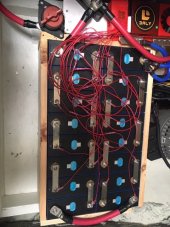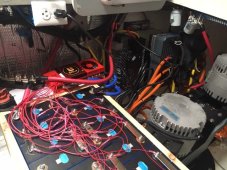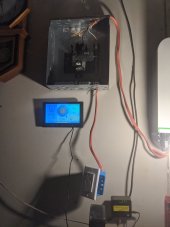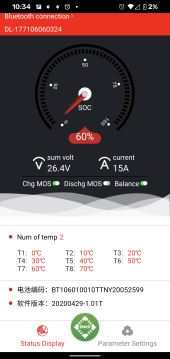I have a 400amp Daly nonsmart BMS that I just installed on my 48V 300AH bank. The cells are A rated from Solar Supply House and are showing 52.5 volts at the terminals. I have a Delta-Q 1200 25amp charger. The charger starts up when I plug it in and the charging (lightning bolt) begins flashing but the voltage did not increase overnight so I suspect the BMS is not allowing the bank to charge. The motors are operating normally. Any ideas of where to begin troubleshooting?
You are using an out of date browser. It may not display this or other websites correctly.
You should upgrade or use an alternative browser.
You should upgrade or use an alternative browser.
BMS not charging my bank
- Thread starter teecomp
- Start date
sunshine_eggo
Happy Breffast!
Did you top balance your cells?
What are the 16 cell voltages when the charger is energized?
What current do you measure coming out of the charger when energized?
What is the charger output voltage when disconnected from the battery?
What are the 16 cell voltages when the charger is energized?
What current do you measure coming out of the charger when energized?
What is the charger output voltage when disconnected from the battery?
I didn't top balance. These were grade A cells from US supplier (recommended by Will) and arrived in mid-November and all measured within 1/100 of a volt using my Blue Sea multimeter. The total voltage is 52.5 volts.
I am a newbie and do not know how to measure the charger current but would appreciate some instructions.
I don't believe the charger is engaging at all. I think the problem is in the Daly. I've tried jumpstarting the Daly by touching a spare battery cable from the P- post to the B- on the bank (with the BMS still connected in the circuit) and it sparked the first time but not on subsequent attempts. Could I have fried the BMS or sent it into some type of shut down protection mode? It is a non smart model so I have no way to monitor it.
Or could the SOC for the bank simply not yet be calling for a charge since Lithium like to cycle and not be topped off? I am installing these on a sailing catamaran with separate, identical propulsion banks, and I am getting the same results on both sides.
I am a newbie and do not know how to measure the charger current but would appreciate some instructions.
I don't believe the charger is engaging at all. I think the problem is in the Daly. I've tried jumpstarting the Daly by touching a spare battery cable from the P- post to the B- on the bank (with the BMS still connected in the circuit) and it sparked the first time but not on subsequent attempts. Could I have fried the BMS or sent it into some type of shut down protection mode? It is a non smart model so I have no way to monitor it.
Or could the SOC for the bank simply not yet be calling for a charge since Lithium like to cycle and not be topped off? I am installing these on a sailing catamaran with separate, identical propulsion banks, and I am getting the same results on both sides.
houseofancients
Solar Wizard
top balancing is always required, no matter who the supplier isI didn't top balance. These were grade A cells from US supplier (recommended by Will) and arrived in mid-November and all measured within 1/100 of a volt using my Blue Sea multimeter. The total voltage is 52.5 volts.
I am a newbie and do not know how to measure the charger current but would appreciate some instructions.
I don't believe the charger is engaging at all. I think the problem is in the Daly. I've tried jumpstarting the Daly by touching a spare battery cable from the P- post to the B- on the bank (with the BMS still connected in the circuit) and it sparked the first time but not on subsequent attempts. Could I have fried the BMS or sent it into some type of shut down protection mode? It is a non smart model so I have no way to monitor it.
Or could the SOC for the bank simply not yet be calling for a charge since Lithium like to cycle and not be topped off? I am installing these on a sailing catamaran with separate, identical propulsion banks, and I am getting the same results on both sides.
look at the resource selection on the forum on how to top balance
sunshine_eggo
Happy Breffast!
I didn't top balance. These were grade A cells from US supplier (recommended by Will) and arrived in mid-November and all measured within 1/100 of a volt using my Blue Sea multimeter. The total voltage is 52.5 volts.
Batteries ship at a reduced state of charge due to hazmat requirements. Legally, they can't be above 30%; however, they are often as high as 50%. At this SoC range, voltages almost always measure completely identically regardless of small variations in SoC. This is not an indication of balance at all. The only time cells are balanced is when they are at the same SoC. The only time you can say they are at the same SoC with 100% certainty is when they are completely full at 3.65V/cell or when they are completely empty at 2.50V/cell.
"grade a"
"recommended by Will"
"US Supplier"
None of the above provide confidence that a pack is top balanced. Even the smallest of SoC variations - as little as 0.1% - can create imbalance to the point the BMS cuts off charging.
You likely need to top balance your batteries.
I am a newbie and do not know how to measure the charger current but would appreciate some instructions.
DC clamp ammeter.
I don't believe the charger is engaging at all.
That may be the problem. Checking for current would help establish that.
I think the problem is in the Daly. I've tried jumpstarting the Daly by touching a spare battery cable from the P- post to the B- on the bank (with the BMS still connected in the circuit) and it sparked the first time but not on subsequent attempts.
I believe that is normal.
Could I have fried the BMS or sent it into some type of shut down protection mode? It is a non smart model so I have no way to monitor it.
Possibly. You could manually measure your cells to check their voltage.
Or could the SOC for the bank simply not yet be calling for a charge since Lithium like to cycle and not be topped off?
It doesn't work like this. The BMS is simply there as a safety system - monitoring cells and cutting out when limits are exceeded. If the battery's voltage is below the applied voltage, current flows into the battery. A 16S battery is fully charged at 56.8-58.4V.
I am installing these on a sailing catamaran with separate, identical propulsion banks, and I am getting the same results on both sides.
So you have two different batteries with two different BMS with two different chargers?
Now is also a good time to triple check all cell connections and that all BMS leads are properly crimped.
littleharbor2
Solar Addict
Check your voltage at the + and - battery output terminals then check the voltage at the + on the battery and - BMS output cable. If you are showing voltage at the BMS it's likely the BMS is ok. Try charging your battery while bypassing the - BMS output and connecting directly to the - of the battery. If you see charging then you may have a problem with the BMS. Don't forget to disconnect the charging source after trying this. I'm sure there's other possibilities as to your charging issue but doing this you can verify what is, or isn't working.
Thanks for the reply. Lots of good info. I watched Will's youtube channel video on how to top balance. In the text portion of the post, Will states "If you have new/high quality cells, and you pull full capacity with normal BMS, no real need to top balance" which is why i skipped this step. I guess I will now revisit this.Batteries ship at a reduced state of charge due to hazmat requirements. Legally, they can't be above 30%; however, they are often as high as 50%. At this SoC range, voltages almost always measure completely identically regardless of small variations in SoC. This is not an indication of balance at all. The only time cells are balanced is when they are at the same SoC. The only time you can say they are at the same SoC with 100% certainty is when they are completely full at 3.65V/cell or when they are completely empty at 2.50V/cell.
"grade a"
"recommended by Will"
"US Supplier"
None of the above provide confidence that a pack is top balanced. Even the smallest of SoC variations - as little as 0.1% - can create imbalance to the point the BMS cuts off charging.
You likely need to top balance your batteries.
DC clamp ammeter.
That may be the problem. Checking for current would help establish that.
I believe that is normal.
Possibly. You could manually measure your cells to check their voltage.
It doesn't work like this. The BMS is simply there as a safety system - monitoring cells and cutting out when limits are exceeded. If the battery's voltage is below the applied voltage, current flows into the battery. A 16S battery is fully charged at 56.8-58.4V.
So you have two different batteries with two different BMS with two different chargers?
Now is also a good time to triple check all cell connections and that all BMS leads are properly crimped.
Thanks for the reply. So when you say try charging while bypassing the BMS output, are you saying to disconnect the bms and hook the charger directly to the battery bank?Check your voltage at the + and - battery output terminals then check the voltage at the + on the battery and - BMS output cable. If you are showing voltage at the BMS it's likely the BMS is ok. Try charging your battery while bypassing the - BMS output and connecting directly to the - of the battery. If you see charging then you may have a problem with the BMS. Don't forget to disconnect the charging source after trying this. I'm sure there's other possibilities as to your charging issue but doing this you can verify what is, or isn't working.
littleharbor2
Solar Addict
The BMS is only connected to the - battery terminal by the large cables. So if you disconnect that - cable you can connect your charging source directly to the battery for this test.Thanks for the reply. So when you say try charging while bypassing the BMS output, are you saying to disconnect the bms and hook the charger directly to the battery bank?
YahwehisKing
New Member
- Joined
- Mar 5, 2022
- Messages
- 25
I was about to post a new thread about this but I found this to be similar to my situation and from your reply seem knowledgeable and the right person to ask.Batteries ship at a reduced state of charge due to hazmat requirements. Legally, they can't be above 30%; however, they are often as high as 50%. At this SoC range, voltages almost always measure completely identically regardless of small variations in SoC. This is not an indication of balance at all. The only time cells are balanced is when they are at the same SoC. The only time you can say they are at the same SoC with 100% certainty is when they are completely full at 3.65V/cell or when they are completely empty at 2.50V/cell.
"grade a"
"recommended by Will"
"US Supplier"
None of the above provide confidence that a pack is top balanced. Even the smallest of SoC variations - as little as 0.1% - can create imbalance to the point the BMS cuts off charging.
You likely need to top balance your batteries.
DC clamp ammeter.
That may be the problem. Checking for current would help establish that.
I believe that is normal.
Possibly. You could manually measure your cells to check their voltage.
It doesn't work like this. The BMS is simply there as a safety system - monitoring cells and cutting out when limits are exceeded. If the battery's voltage is below the applied voltage, current flows into the battery. A 16S battery is fully charged at 56.8-58.4V.
So you have two different batteries with two different BMS with two different chargers?
Now is also a good time to triple check all cell connections and that all BMS leads are properly crimped.
I have a 16s 280ah build all new eve cells grade A so I didn't top balance -_- same reason as this thread creator. I'm using a 100amp 16s Daly with UART, and a 3k Growwatt lvm es I believe. I don't know if the BMS is dead a few things you stated makes me think it's not, I get same voltage on P- and B-. The cell harness is correct and goes up in the correct increments, my Growwatt says it's charging, at first the solar was charging and then would rest and go and rest and go but with no errors or faults I disconnected everything and reconnected and there doesn't seem to be that issue any more . My thing is my Bluetooth app reads incorrect data and I can't connect via USB I can establish a port but no communication occurs so I don't know if the cells are being balanced or equally charged. I was reading the cells this morning and the last cell and first cell will read 3.5-3.7 whiler charging but the others at the same time are 3.45 and rising. I don't know if that's a problem and the BMS isn't working properly or what Ill attach pics.
Attachments
Similar threads
- Replies
- 0
- Views
- 290
- Replies
- 9
- Views
- 386








